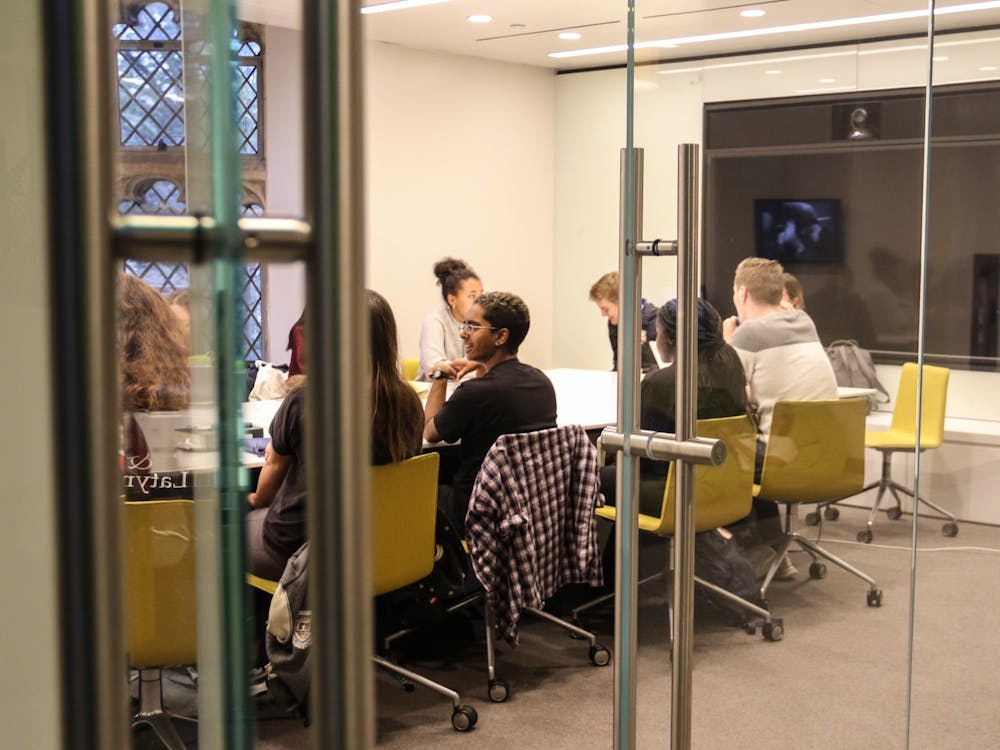The Brodhead Center feeds thousands of students every day. Sazón alone makes 700 to 800 arépa bowls and 100 to 200 quesadillas daily. Where does all of the food come from?
At the Duke University Student Dining Advisory Committee meeting Wednesday, student representatives toured the Brodhead Center kitchens. The tour was led by Aris Marton, associate director of retail operations for Duke Dining, and Coleman Norris, executive chef of a handful of Brodhead Center locations including the Commons, JB's Roasts and Chops, The Skillet and Chef’s Kitchen.
“I always think of a kitchen like a hospital—a kitchen should be just as sterile,” Marton said.
Almost all of the food in the Brodhead Center is prepared and cooked in the active working kitchen behind Au Bon Pain and Devil’s Krafthouse. Here, DUSDAC members were led through the kitchen to see a broad view of how it operates with various restaurants sharing around 5,000 pieces of equipment.
DUSDAC members entered the kitchen and toured the industrial fridges, where meat and fresh produce are kept at a consistent 41 degrees Fahrenheit and separated to prevent cross-contamination.
Particularly given the challenges of such a large space, Norris emphasized that safety is “put at the forefront of everything we do.”
The loading dock—shared by the Brodhead Center, Penn Pavilion and Page Auditorium—receives up to 57 shipments each day. Many of these deliveries come in before 4:30 a.m.
On Mondays, Wednesdays and Fridays, when food is delivered, “it’s a wonderfully skilled ballet out there,” Marton said.
Along the tour, various chefs explained the staggering numbers of the amount of food produced and consumed in the Brodhead Center.
Per week, these include 700 to 900 dough balls for Il Forno pizzas and breadsticks and 1,040 pounds of chicken for chicken dishes at the Devil’s Krafthouse. About 200 pounds of onions and 200 pounds of cabbage are prepared and sent upstairs to Tandoor every day.
Marton noted that leftover food scraps from students are put into a pulper for compost and are eventually wheeled out to the loading dock to be picked up by a compost company.
One of the most specialized machines in the kitchen is the gelato maker at Café. For the opening of the Brodhead Center, the chef at Café traveled to Italy to get trained in the art of gelato making. He has since passed down the skill, and 100 gallons of gelato are made for Café every day along with 500 coffee drinks.
Tandoor, which has been on Duke’s campus since 1998, long before the Brodhead Center, has a separate prep space from the restaurants because they prepare halal meat. These meats are kept separate from non-halal meat.
In the cold prep room, Gyotaku and Ginger and Soy cut all their fish. This ensures that raw fish for sushi will stay fresh throughout the preparation process. Here, about 200 pieces of JB’s salmon are also prepped each day.
Of all the restaurants that use the downstairs kitchen space, Sazón, Tandoor and Ginger & Soy often lead in overall popularity. The ranked popularities of these restaurants are based on which bring in the most checks—counts of transaction frequencies and amounts at each restaurant. However, there has been a general trend of an increase in checks since last year, which may indicate that students are eating more or eating at the Brodhead Center more often.
“Duke Dining has so much invested in the future of every student here at Duke by feeding them nutritious foods with our operators here on campus,” Marton said.
Get The Chronicle straight to your inbox
Signup for our weekly newsletter. Cancel at any time.

Paige Carlisle is a Trinity senior and a staff reporter for The Chronicle.

